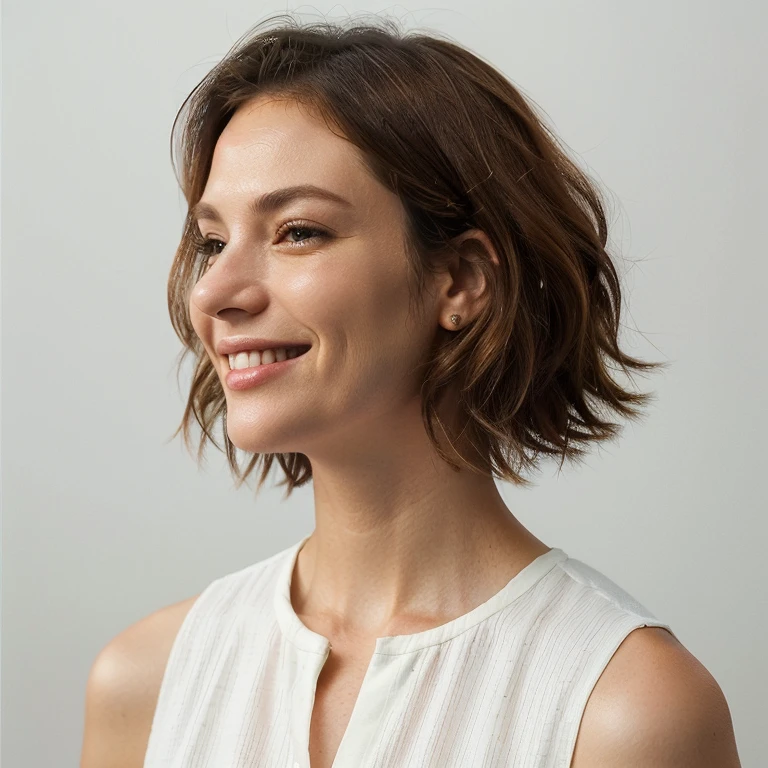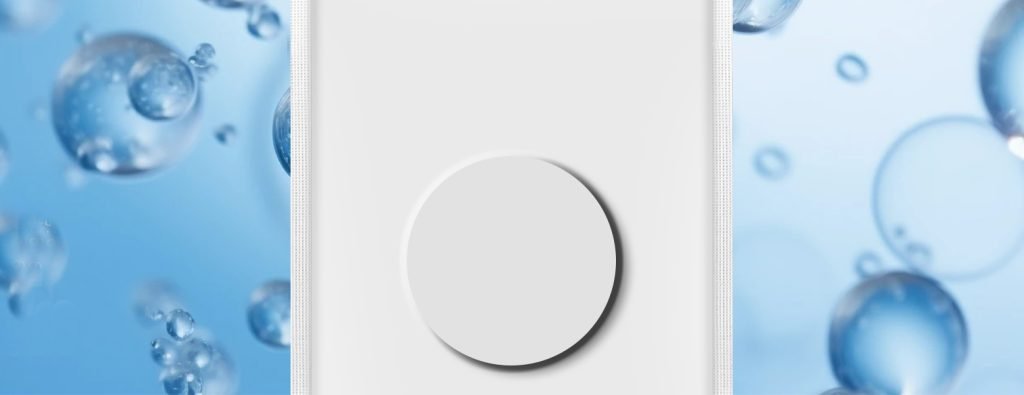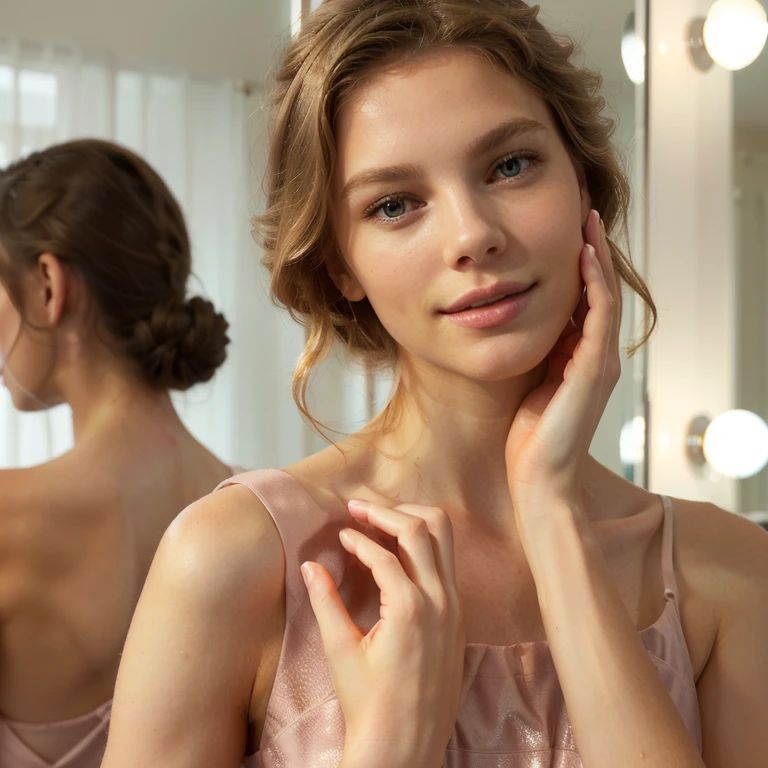From a 12-year-old teenager to a 35-year-old professional, pimples are like those uninvited guests who pop up just when you least expect them. In “Every Secret of Pimples: Your Go-To Guide for Skin Care,” we’re diving into the nitty-gritty of what makes pimples tick and how to send them packing. This guide covers it all: from why these pesky blemishes decide to crash on your skin to the best strategies to bid them goodbye. Whether you’re dealing with the occasional pimple or a more persistent acne battle, we’ve got the scoop that’ll help clear the way for smoother, happier skin. So, grab your magnifying glasses and join us on this pimple-popping journey of discovery!
Secret No.1: What are Pimples?
A pimple is a type of acne that occurs when the pores of your skin become blocked with oil, dead skin cells, and bacteria. It can present as a blackhead, whitehead, pustule, or cyst.
Propionibacterium acnes(P. acnes), the bacteria found naturally on the skin, flourishes in these clogged pores. Its growth triggers an immune response, leading to inflammation and the red, swollen appearance of pimples.When the excess oil mixes with dead skin cells, it creates a plug in the follicle, trapping bacteria inside. The bacteria multiply, leading to inflammation, swelling, and the formation of a pustule or a cystic lesion.
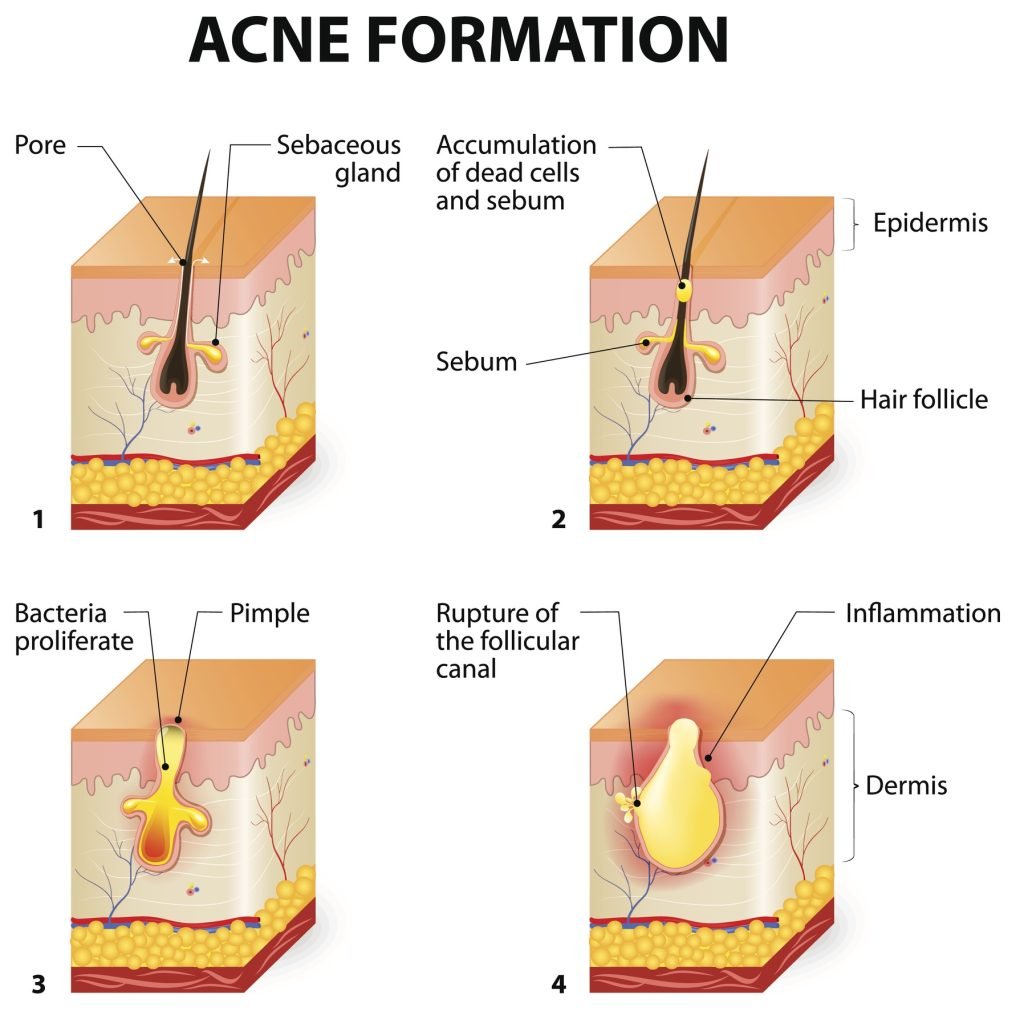
The formation of pimples in short, is a process that bacteria invasion resulting in infection and inflammation.
Secret No.2: What Other Names and Types of Pimples Are There?
Vocabulary of Acne
Pimples are also commonly referred to as zits or spots. In medical terms, this condition is acne vulgaris, a term that covers several types of skin blemishes.
Types of Acne Lesions(Pimples)
- Comedones: These are non-inflammatory acne lesions that can be open (blackheads) or closed (whiteheads). They form when pores are clogged with excess oil and dead skin cells.
- Papules and Pustules: These are small, raised bumps that indicate inflammation or infection in the hair follicles. Papules are usually red and tender, while pustules are what people typically think of as pimples — red with pus at their tips.
- Nodules and Cysts: These are larger, deeper, and more severe forms of acne that occur when clogged, swollen pores endure further irritation and grow larger. Nodules are hard and painful, and cysts are softer because they are filled with pus.
The severity of acne can range from mild (few, occasional pimples), moderate (inflammatory papules and pustules) to severe (nodules and cysts). Severe acne is more likely to cause scarring and requires more comprehensive treatment.
Secret No.3: Why do some people tend to have pimples than others?
Is hormone going to cause more pimples?
Hormonal fluctuations are a primary driver of pimple formation. During puberty, the increased levels of androgens (male hormones present in both males and females) cause sebaceous glands to enlarge and produce more sebum. Similarly, hormonal changes during menstruation and pregnancy can also trigger acne flare-ups as the body experiences shifts in hormone levels, particularly estrogen and progesterone, which can increase oil production and skin sensitivity.
Does my medicine spike more pimples?
Certain medications can exacerbate or trigger the development of acne. For example, corticosteroids, lithium, and medications used for epilepsy can alter hormone levels or directly affect skin’s oil production. It’s essential for individuals on long-term medication to consult with healthcare providers about possible side effects on the skin.
How is my diet related to my pimples?
Recent research has highlighted the impact of diet on acne. Studies have shown that diets with a low glycemic(blood sugar) load can lead to fewer acne by reducing factors that contribute to acne formation, such as insulin levels and the resultant skin oil production. Dairy, particularly milk, contributes to acne due to its ability to increase insulin levels, which in turn can exacerbate acne symptoms. Consuming diets low in processed sugars and high in omega-3 fatty acids, like those found in fish and healthy oils, has been beneficial for individuals with acne. Such dietary adjustment influence the hormonal and inflammatory responses that lead to acne, providing a non-pharmacological strategy that may enhance conventional acne treatments.
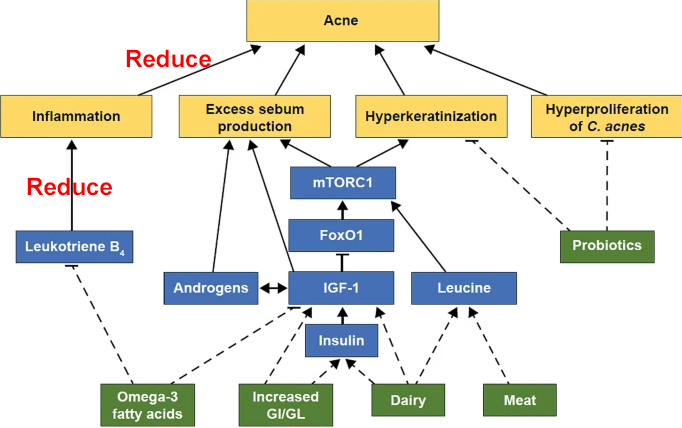
In general, increasing fish and vegetable intake and lowering the proportion of dairy and high glycemic food in your diet can suppress pimples. Source: AJCD
Do you have more pimples under stress?
Stress can significantly impact acne. It triggers the release of cortisol, another hormone that can increase oil production in the skin. Managing stress through techniques such as mindfulness, exercise, or adequate sleep can help reduce the severity and frequency of acne breakouts.
Is there anyone in your family who usually also had pimples?
Genetics also play a crucial role in acne development. If immediate family members have a history of severe acne, there is a higher chance of developing similar conditions. Genetics can influence how the immune system responds to bacteria, how much oil the skin produces, and how easily the pores are clogged.
Secret No.4: What is Inside Pimples?
The content of a pimple can vary depending on its type. Typically, a pimple is filled with a mixture of sebum, dead skin cells, bacteria, and white blood cells.
White blood cells, part of the body’s immune response, rush to the site of a clogged pore to fight the bacteria. Their accumulation, along with the bacterial breakdown, forms pus, which is what gives some pimples their white or yellowish appearance at the tip.
The pus in a pimple primarily contains neutrophils, which are a type of white blood cell, along with other cellular debris. This mixture is often responsible for the pressure and inflammation associated with pimples.
Why Pimples Vary in Appearance
The appearance and content of pimples can differ based on the depth and severity of the infection. For example, blackheads are open comedones that contain melanin, which oxidizes and turns black upon exposure to air, while cysts contain a deeper, more painful accumulation of pus.
Secret No.5: How Does Your Body Clear Pimples?
The body’s primary response to a pimple begins with the immune system. White blood cells, particularly neutrophils, rally to the site of infection to eliminate bacteria and initiate healing.
As the immune response progresses, the inflammation typically subsides. The pimple may drain naturally, with the body absorbing the debris or expelling it through the skin’s surface. This process can result in the pimple reducing in size and redness, eventually healing without visible marks.
Following the clearing of the pimple, the skin undergoes a process of regeneration. New skin cells are produced to replace those damaged by the pimple, and in optimal conditions, the skin can heal without scarring.
Proper skincare, including gentle cleansing and the use of non-comedogenic moisturizers, can support the natural healing process. These practices help maintain a clean and balanced skin environment, preventing further irritation and promoting faster recovery.
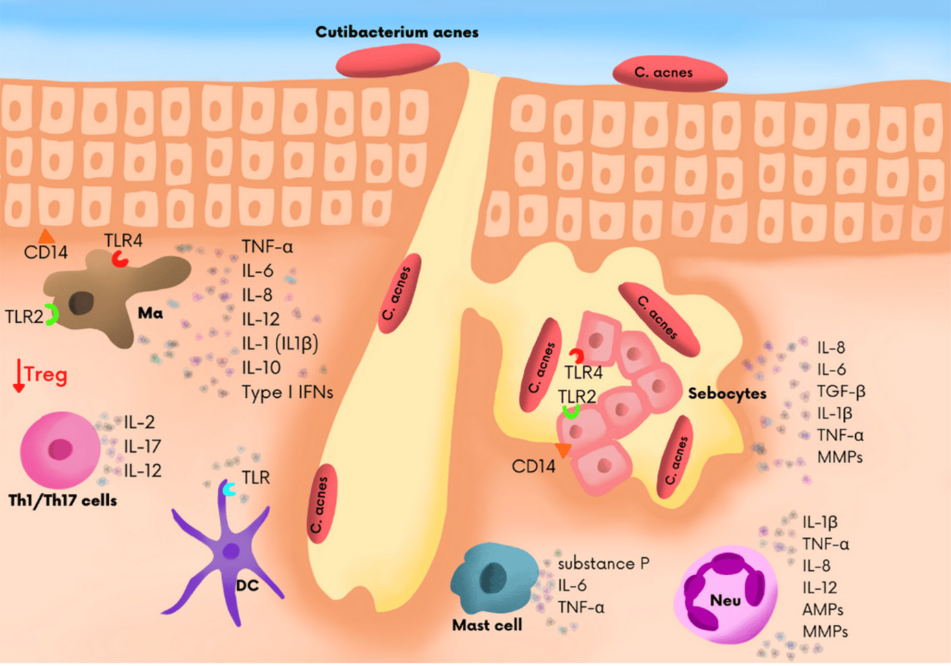
Clearing pimple is a process involved immune system fighting and skin cell regenerating Source: JCM
Secret No.6: How Do You Treat Pimples?
Treating pimples effectively involves a combination of over-the-counter (OTC) products, prescription medications, and lifestyle modifications.
OTC Products and Topical Treatments
For mild to moderate acne, OTC products containing ingredients like benzoyl peroxide, salicylic acid, and sulfur can be effective. These substances help reduce oil production, promote skin cell turnover, and fight bacterial infection in the pores.
Prescription Medications
More severe cases may require prescription treatments such as retinoids, antibiotics, or hormonal therapies. These medications are to reduce severe inflammation, combate deep bacterial infections, and regulate hormone levels that contribute to acne.
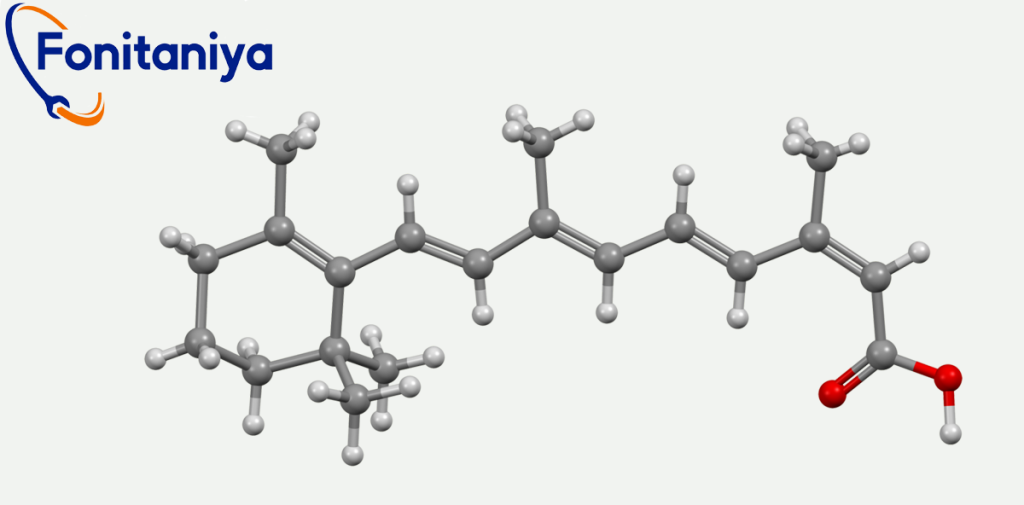
Isotretinoin, a nuclear weapon for treating acne, is prescribed by physicians with cautions.
Lifestyle and Dietary Adjustments
Just like we have discussed before, simple changes in daily habits, such as adopting a balanced diet, reducing stress, and maintaining a regular skincare routine, can significantly impact acne management. Avoiding foods known to trigger acne and managing stress through exercise or meditation can also be beneficial.
Alternative and Emerging Treatments
Recent advances in dermatological treatments include light therapy and chemical peels, which can help treat stubborn acne. Additionally, natural remedies like tea tree oil and green tea lotions have been recognized for their anti-inflammatory properties.
Secret No.7: Do Pimple Patches Work on Pimples?
Pimple patches are small adhesive stickers that can be applied directly to a pimple. They are typically made from hydrocolloid material, which helps to absorb exudate such as pus and oil, creating a moist environment that promotes healing.
Mechanism
The hydrocolloid in the patches works by drawing out fluids and protecting the affected area from external bacteria and irritants. This isolation not only speeds up the healing process by keeping the area clean but also reduces the risk of scarring by minimizing picking or touching.
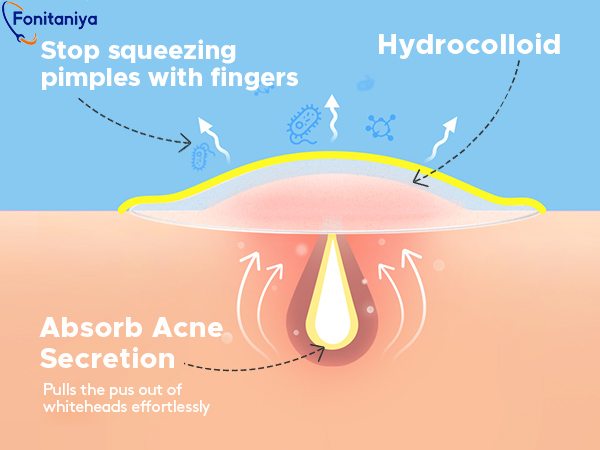
Pimple patches provides an ideal environment for speeding up recovery
Effectiveness on Different Types of Acne
Pimple patches are most effective on superficial kinds of acne like whiteheads. For deeper, cystic acne, pimple patches are less effective, although some patches are now infused with active ingredients like salicylic acid or tea tree oil to enhance their acne-fighting capabilities.
To learn more about how pimple patches work on different types of pimples, please read this.
Studies have shown that pimple patches can reduce healing time and inflammation quickly compared to some topical treatments. They are especially beneficial for people who struggle with the urge to pick at their pimples, as the patch physically blocks access to the blemish.
Integrating into a Skincare Routine
Pimple patches can be a useful addition to a skincare routine, particularly for managing occasional breakouts. They’re discreet enough to be worn during the day and can be especially handy for overnight use.
Conclusion
In conclusion, understanding the various facets of pimples—from their formation to effective treatment methods—is the basis for managing this common skin condition. Pimple patches, specifically, can be an easy and convenient treatment for pimples. These patches work by absorbing pus and protecting the affected area, thus accelerating the healing process and preventing further irritation. When used correctly and in conjunction with a comprehensive skincare routine, pimple patches can provide relief from inflammation and help manage acne with minimal side effects, making them a valuable tool in the fight against pimples.
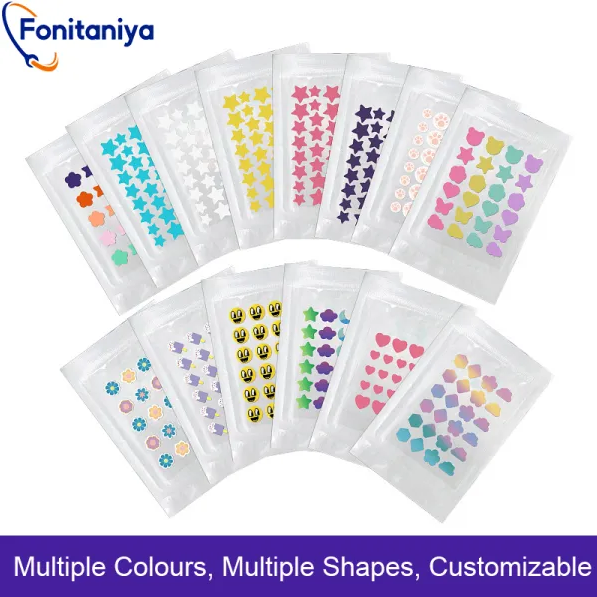
Our DIY pimple patches; We also welcome customisations
Our brand, Fonitaniya, not only produces high-quality, skin-friendly pimple patches but also specializes in DIY pimple patches/customized hydrocolloid patches tailored to meet diverse customer needs. With over 13 years of experience in producing tapes and other adhesive products in a B2B framework, Fonitaniya keep innovating in better quality, ensuring our products stand out in the skincare market. Whether you’re looking for standard solutions or bespoke products, Fonitaniya offers reliable and effective skincare enhancements for every need.
FAQs
Do Pimple Patches Work?
Yes, pimple patches can be effective in treating acne, particularly for surface-level lesions like whiteheads. They help reduce inflammation, prevent the urge to pick at pimples, and can speed up the healing process.
What Do Pimple Patches Do?
Pimple patches protect the affected area, absorb exudate (like pus and oil), reduce inflammation, and minimize the spread of bacteria. This promotes a clean and optimal healing environment for mild to moderate acne.
Do Pimple Patches Work for Whiteheads/Blackheads?
Pimple patches are most effective on whiteheads, which are filled with pus and more receptive to the type of treatment hydrocolloid provides. They are less effective on blackheads, as these are open comedones without a layer of skin over the plug of oil and dead skin.
How Long to Leave a Pimple Patch On?
It’s best to leave a pimple patch on for at least several hours or overnight to allow the hydrocolloid material enough time to absorb fluids from the pimple. Generally, a patch should be replaced once it turns white from the absorbed pus.
What Are Some Alternatives to Pimple Patches?
Alternatives to pimple patches include topical treatments with benzoyl peroxide or salicylic acid, oral medications, and therapies like light treatment or chemical peels, depending on the severity and type of acne.
What to Do After Removing a Pimple Patch?
After removing a pimple patch, clean the area gently with a mild cleanser to remove any residue and apply a non-comedogenic moisturizer to keep the skin hydrated. Avoid applying harsh topical treatments immediately unless directed by a dermatologist.
What is Inside of a Pimple?
A pimple typically contains a mixture of sebum, dead skin cells, bacteria, and immune cells (like white blood cells). These components combine to form pus, which accumulates as the body reacts to what it perceives as an infection.
Do Hydrocolloid Patches Work?
Yes, hydrocolloid patches work by absorbing moisture from the lesion, which helps reduce the size and redness of pimples and speeds up the healing process while protecting the area from external irritants and infections.

